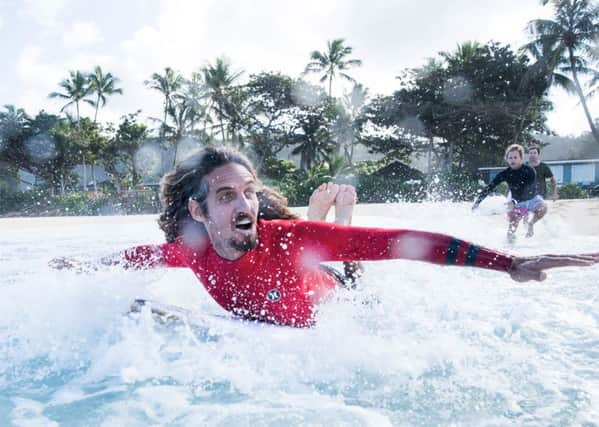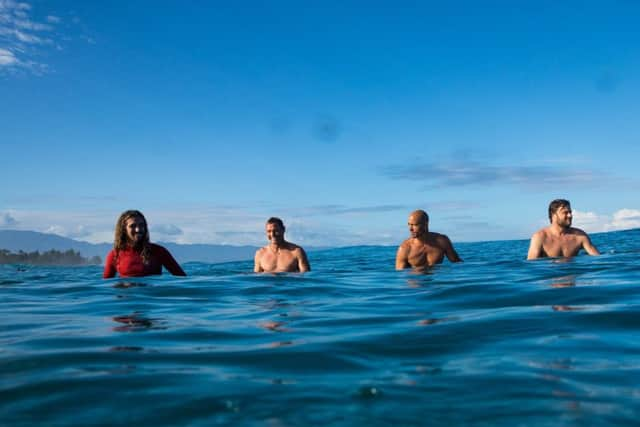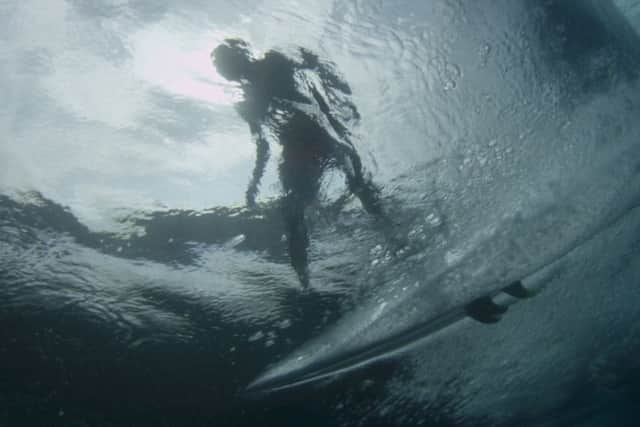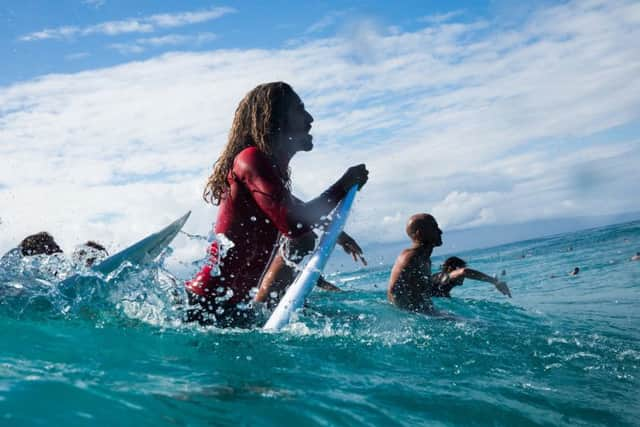'We laughed, we cried' - surf star Rob Machado on the film that reunited the Momentum Generation


Directed by (non-surfing) brothers Jeff and Michael Zimbalist, makers of sports documentaries including The Two Escobars and Pele: Birth of a Legend, the film takes its title from another surf flick, Momentum, released in 1992. Made by a then almost unknown young filmmaker called Taylor Steele, it starred Slater, Machado and Co and took a flamethrower to the notion of what a surf film was supposed to be.
Up until this point, surf films had tended to follow the format pioneered by Bruce Brown in the 1960s: a small group of surfers travel to a remote location, surf perfect waves and strike photogenic poses, all backed by tasteful music and narration. In Steele’s early films, however (he made Momentum II in the following year and Focus in 1994) there was no story to speak of – just a feast of frenetic, edgy, no-holds-barred surfing, all given an appropriately raucous soundtrack by bands like Pennywise and The Offspring.
Advertisement
Hide AdAdvertisement
Hide AdWhen Momentum was released many of the featured surfers were barely out of high school, but in just a few short years they would come to dominate the world tour, and in December 1995 Machado and Slater found themselves at the epicentre of the surfing universe when they competed against each other in an iconic world title decider at the Pipe Masters in Hawaii.


That was perhaps the defining moment of the Momentum generation, but it was also the point at which the group started to drift apart. Slater went on to become a competitive force of nature, racking up a staggering 11 world titles; Machado, plagued by injury, eventually dropped off the world tour, and in 2009 made a film called The Drifter with Steele which helped him transition from competitor to sponsored freesurfer. Dorian became one of the world’s greatest big wave surfers, his determination to excel in giant surf partly inspired by the tragic death in 1997 of Todd Chesser, a Hawaiian who had acted as a mentor to the group, challenging them to surf bigger and more dangerous waves when they were struggling to find their feet on the North Shore. Some of the Momentum crew found themselves in some pretty dark places, too – Weatherley struggled with addiction, while Robb, once touted as “the next Kelly Slater,” found himself stuck working in an office job he hated.
All of this and much more comes out in the extensive interviews conducted for the film by the Zimbalists – and they really were extensive. When I speak to Machado about the film, he tells me he did one mammoth eight hour interview and another that was between four and five hours.
“It was very intense,” he says. “I would say I ran the whole gamut of emotions. It felt more like interrogation sometimes, you know, we laughed and cried... They definitely like to rattle the cage as far as the emotions go, and that’s to their credit, that’s a skill that not a lot of people have.”
Although various feuds and rivalries caused the group to splinter, Surfer Magazine oversaw a Momentum reunion in 2012, and Machado says that not only helped bring the group back together but also laid the foundations for the new film. Now, after the cathartic process of making it, the Momentum surfers are as close as they were in their mid-90s heyday.


“When the film was finished we all flew to New York, a good little crew of us,” says Machado. “We sat in a little private theatre and we had a screening, and we all kinda walked out of there and just gave each other a hug.
“I think we all learned a lot about each other, and I think there’s a lot of stuff that we never talked about, the air never really got cleared and it was just... it was good to kinda just flush it all out.”
When Machado talks about having his cage rattled by the Zimbalists, he’s referring in particular to their questions about his friendship and rivalry with Slater. Much like Sean White and Kevin Pearce in the snowboarding world, the two started out as friends, but when it became clear that Machado was the only one of the Momentum surfers who could seriously challenge Slater for the world title, their relationship became strained. The falling-out they had over Slater using a brand new surfboard that had just been shaped for Machado, detailed in the film, has echoes of some of the squabbles between White and Pierce that came to light in the 2013 documentary, The Crash Reel.
Advertisement
Hide AdAdvertisement
Hide AdThings really came to a head in December 1995. That year, the surfing world title came down to the wire at the final event of the season - the Pipe Masters, held in the reeling, spitting, bone crunching waves of Pipeline on the north shore of Oahu. Going into the contest, Hawaiian veteran Sunny Garcia, who both looked and surfed like a heavyweight boxer, was leading the field. All he had to do was advance to the third round at what was effectively his home break and the title would be his. A disaster heat against resurgent Aussie Mark Occhilupo in Round Two, however, meant that the race was suddenly wide open and both Machado and Slater, second and third in the rankings respectively, had a chance of winning the title. When the pair met up in the semis, they knew it was all or nothing, and yet... they didn’t act like it. Instead of hassling each other for waves, they were happy to trade perfect tube rides, even playing scissors, paper, stone to decide who got to go first.


Then, towards the end of the heat, a moment of pure stoke or of ugly controversy, depending on your point of view. As Machado came screaming out of yet another enormous circular waterfall, there was Slater on the shoulder, his arm raised, hand outstretched. Machado did what almost anyone would have done in the circumstances: carved a big turn towards his friend and high-fived him as he zipped past.
In doing so, however, Machado ended up nearer the beach that he would have done and lost priority - the right to catch the next wave. Slater went on to win the heat and then beat Occhilupo in the final, denying Machado would have been his first world title by the narrowest of margins.
The debate over whether Slater’s high-five was a sly bit of gamesmanship or a genuine reaction to seeing his friend getting barrelled has raged for over two decades, and it is revisited again in Momentum Generation. Some of the surfers interviewed - including Garcia and the British surfer Martin Potter - clearly think the high-five was a ploy by Slater to con his friend into conceding priority, but Machado doesn’t think so and he says as much in the film. Slater claims the high-five was well intentioned, but if he did have ulterior motives this film would hardly be the place to reveal them. Perhaps the most accurate guide to what really happened in that moment is how it felt for Machado. What was his gut reaction at the time? Did it feel like a genuine high-five?
“Oh, 100 per cent yeah, it felt genuine,” he says. “And I think that’s what made that moment so appealing to a lot of people. For a lot of people that surf, that’s something you would envision doing if you weren’t in a contest, right? Like if you caught that wave and your best friend was paddling out, you would probably high five your best friend.
“There’s a lot of different takes on it. [In the film] you hear Sunny... we all know his take, and Pottz [Martin Potter] says that Kelly’s so calculating and so manipulative, but I honestly don’t think he was at that moment. I think we were so far along in the heat that it was actually irrelevant at that time. Everyone has this idea that he got priority and he went out and he got the wave to win the heat, but no - the heat was pretty far gone at that point.”
What Machado does remember from the heat is a sense of disbelief that he and Slater - still in their early 20s - had come so far, so quickly.
“During that heat I remember turning to Kelly and just saying ‘Dude, this is pretty crazy that we’re out surfing Pipeline.’ I mean literally two years before that we weren’t catching any waves at Pipeline at all.”
Advertisement
Hide AdAdvertisement
Hide AdThe story of how Machado and Slater came to find themselves sitting out there together alone at Pipe, trading tubes for the world title in front of a hundred long-lenses having leapfrogged some of the most intense competitors the sport has ever known, is one of the main plotlines of Momentum Generation. As the title suggests, however, the duo didn’t simply come out of nowhere to dominate the sport - they were part of a talented gaggle of young surfers which, in the early 1990s, started to coalesce around the home of Benji Weatherley, a surfer whose mother had recently moved into a house on the beach at Pipe following the breakdown of her marriage.
For young mainland surfers like Slater (from Florida) and Machado (from California), it was one thing to do well in small waves at home; quite another to come to Hawaii and prove yourself in the monster-sized surf of Oahu’s North Shore. The waves themselves were terrifying enough, and then there were the locals, who, to put it mildly, didn’t take kindly to their best breaks being overrun by outsiders.
“You go back to like ‘93, ‘92,” remembers Machado, “and I wasn’t paddling out at Pipe and catching any waves. There was Johnny Boy [Gomes] and Derick and Mike [Ho], you know, it was heavy. So that was the first breakthrough moment for me - just to actually catch a few decent waves at Pipe.”
The Weatherley home soon became a sort of informal club hut for a group of young surfers, many of whom had had difficult childhoods, who were trying to make names for themselves on the North Shore. Along with Slater and Machado, those frequently to be found hanging out on the balcony overlooking the break and generally treating the place like a free hotel included Knox, Dorian, Robb, O’Connell and Williams. (Mrs Weatherley, we discover during the film, was a pretty cool mom.) With Chesser acting as a cross between a mentor and a drill sergeant, constantly pushing them to ride bigger and bigger waves, their confidence and ability to handle serous surf went through the roof. And so, in the space of a couple of winters, they went from a bunch of wary outsiders to a dominant force in the water at one of the most treacherous surf spots on the planet.
It was during this period that Taylor Steele started hanging out with the group and recording their every turn and tube ride. These were the days of VHS tape, so screenings at the Weatherley house were strictly limited to one play-through - no rewinds or fastforwards, for fear of damaging the tape. There’s some grainy footage in Momentum Generation of Machado, Slater et al at one of these playback sessions and it’s clear from their reactions that the rivalry within the group was fuelled just as much by the desire to get the best segments in Steele’s films as it was by the desire to win contests.
These days, Machado, 45, is living every surfers dream, getting paid to travel the world and surf in exotic locations with support from his sponsors, for whom his distinctive, casual-yet-deadly surfing style is an invaluable marketing tool.
Machado has always had more of an artistic sensibility than your average world class sportsman - he’s a mean guitar player and his guest-edited edition of Surfer Magazine from August 1995 is a thing of wigged-out psychedelic wonder - so I ask if these days he thinks of surfing as more of an art than a sport.
“I do,” he says, “the whole artistic side of surfing is something that’s always been appealing to me. Looking back to the early days, the best surfers were always deemed based on their style - based on what you looked like riding a wave and the lines you drew. That’s your interpretation, right? And I think that will forever be what deems the best surfers in the world.”
Advertisement
Hide AdAdvertisement
Hide AdI ask if he feels as if he learned anything about himself during the making of Momentum Generation.
“Yeah, I did,” he says, “I walked away thinking ‘Gosh, maybe I was a little single-minded.’ We were all so competitive [in the early days] that I don’t think we really took time to support each other. In the film we kinda talk about it: if you were to open up like that you were probably showing some signs of weakness. I think this movie helped us air out a lot of stuff that we maybe had never talked about or never really acknowledged.”
*Momentum Generation is available on digital download from 5 November